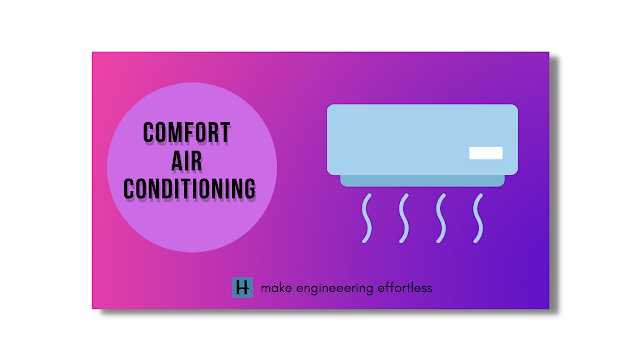Air
conditioning is a process which heats, cools, cleans, and circulates air, as
well as controlling the moisture content of air. Thus, air conditioning makes
it possible to change the condition of air in an enclosed space.
Human comfort:
As
per ASHRAE (American Society of Heating, Refrigerating and Air conditioning Engineers), Human comfort is defined as that condition of mind which expresses
satisfaction with the thermal environment.
Requirement of comfort air conditioning
In
comfort air conditioning, the air is brought to the required dry bulb
temperature and relative humidity for human health, comfort, and efficiency.
If sufficient data of the required condition is not given, then it is assumed
to be 21°C dry bulb temperature
and 50% relative humidity.
The
comfort air conditioning may be adopted for homes, offices, shops, restaurants,
theaters, hospitals, schools, etc…
Effective temperature
The
American society of heating and ventilation engineers (ASHVE) introduced a
scientific method to measure the comfort feeling of human being which is
obtained by a concept of ‘Effective temperature’ used as an index of comfort.
The
effective temperature is defined as an index which correlates the combined effects of
air temperature, relative humidity, and air motion on the human body.
The
particular effective temperature at which majority of the people feel
comfortable is known as optimum effective temperature.
Factors governing optimum effective temperature
Age and gender:
Women
require greater effective temperature (0.5°C) than the man. The
children require higher ET compared with adults. Maternity halls are
maintained higher effective temperature by 2 to 3°c than used for adults.
Climatic and seasonal differences:
The
people living in colder climates feel comfortable at lower effective temperature than
those living in warmer regions. In summer we are adjusted to somewhat higher
temperature (22°C) and in winter to somewhat lower temperature (19°C).
Air velocity:
Air
velocity in the air-conditioned system should be lower enough to avoid the
objectionable noise and it should be higher enough to carry out the heat from the
human bodies.
Clothing:
The
person with light clothing needs less optimum effective temperature than a
person with heavy clothing.
Density of occupants:
The
effect of body radiant heat from person to person particularly in a denser area
like auditorium is large which requires a slight effective temperature.
Kind of activity:
The
persons working in a workshop or dancing hall require lesser effective
temperature compared with people seating in cinema hall or auditoriums.
Duration of stay:
If the stay in a room is shorter (person going to shops) then higher effective temperature is required than that needed for long stay (person working in shops itself).
Comfort chart
Comfort chart is defined as the chart
which gives different percentages of people feeling comfort at different
effective temperature.
1. The percentage of people feeling comfortable
at different ETs for summer and winter conditions is shown in comfort chart.
2. The maximum percentage (100%) of people feeling comfort in summer is shown by line BB. Therefore, the optimum effective temperature in summer is 22°C. The percentage of people feeling comfort is zero at the effective temperature of 18°C and 27°C.
3. The maximum percentage (100%) of people feeling comfort in winter is shown by line AA. Therefore, the optimum effective temperature in winter is 19°C. The percentage of people feeling comfort is zero at the effective temperature of 16°C AND 23°C.
4. The most desirable relative humidity range lies between 30% and 70%. When the RH is below 30%, the mucous membrane and skin become too dry. And there is a tendency for sticky feeling when the RH is above 70%.
5. Considering the RH limitations, the desired comfort conditions must lie between B'B" for summer conditions and between A'A" for winter conditions. The area A'A" B'B" shown on the comfort chart is used for year-round air-conditioning design.
Did you know:
- Modern air conditioning
was invented by Willis carrier in 1902. For the purpose of protecting ink and
paper in a publishing company.
- The first air conditioner was installed in 1914. It was 7 feet height, 6 feet wide, and 20 feet long. Because of its larger size and cost only richer people with bigger homes can afford air conditioning system.
- At the times air
conditioning system cost somewhere about $10,000 to $50,000.
- Air conditioning saves
life. Researchers found that chances of dying due to extremely hot summer is
fallen to 80 percent in the past 50 years. This is because of rise of air
conditioner.

